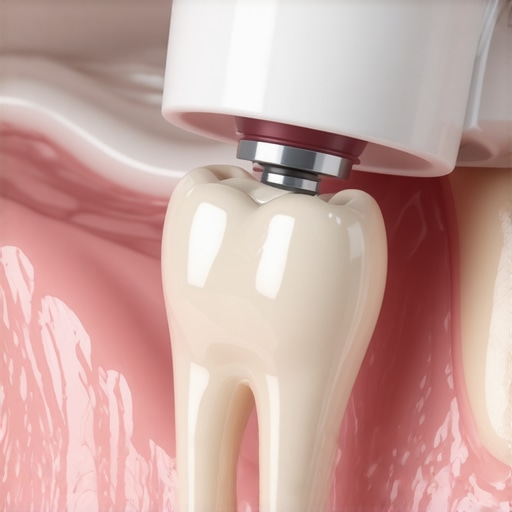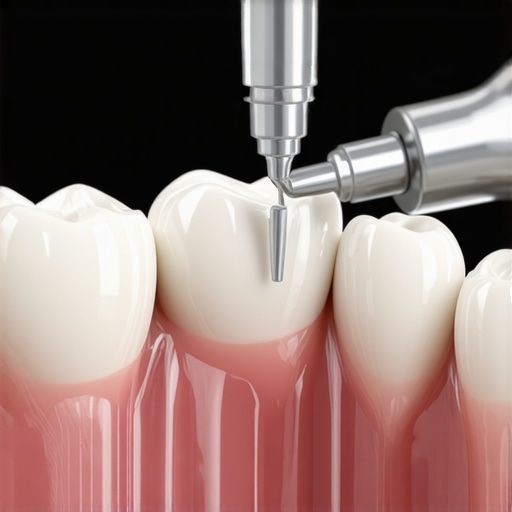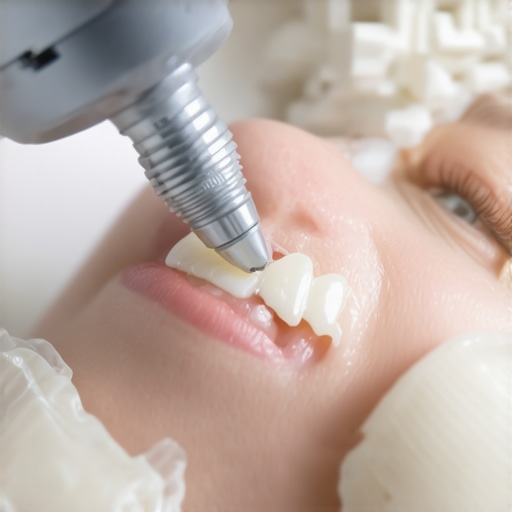My Journey to the Perfect Dental Crown
When I first needed a dental crown, I was overwhelmed by the options and worried about choosing the right one. I remember sitting in my dentist’s office, feeling a mix of anxiety and curiosity. That experience sparked my deep dive into understanding how to select a crown that not only looks great but also lasts for years.
Understanding the Different Types of Crowns – My Personal Insights
After researching extensively, I learned about various crown materials like porcelain, ceramic, metal, and porcelain-fused-to-metal. Each has its pros and cons. For example, I found that porcelain crowns offer a natural look, perfect for front teeth, while metal crowns are incredibly durable, suited for molars that endure heavy chewing. My dentist explained that choosing the right material depends on your specific dental needs and lifestyle. To make an informed decision, I also checked authoritative sources like the American Dental Association, which emphasizes the importance of selecting a durable material suited for your oral habits.
What Factors Should You Consider Before Picking a Crown?
In my experience, the key factors include durability, aesthetics, cost, and how well the crown integrates with your natural teeth. I realized that a good crown should withstand biting forces and resist staining. Plus, matching the crown’s appearance with my natural teeth was crucial for my confidence. I also discovered that proper oral hygiene and regular dental checkups significantly extend the lifespan of a crown. If you’re considering a crown, I recommend discussing these factors thoroughly with your dentist to find the best fit for your needs.
How Do I Know Which Crown Will Last Long-Term?
My personal approach involved asking my dentist about the longevity of different materials. I was surprised to learn that porcelain crowns, when well-maintained, can last 10-15 years, while metal crowns can last even longer. Proper care, such as avoiding biting hard objects and maintaining good oral hygiene, is essential. I also found that regular checkups help catch potential issues early, ensuring my crown stays in top shape. For reliable information, I refer to reputable sources like the [American Dental Association](https://www.ada.org) which provides guidelines on crown maintenance and longevity.
Why is choosing the right crown so important for your dental health?
Choosing the right crown isn’t just about looks; it’s about protecting your underlying tooth and ensuring your oral health for years to come. A poorly selected crown can lead to discomfort, decay, or even the need for future replacements. That’s why I always emphasize consulting with experienced dental professionals who can guide you through the options tailored to your needs.
If you’ve had similar experiences or tips on choosing crowns, I’d love to hear your story in the comments! Sharing our insights can help others make informed decisions about their dental health.
Why Customizing Crowns Can Make All the Difference
In my ongoing exploration of restorative dentistry, I’ve come to appreciate the significance of customization. A one-size-fits-all approach rarely yields optimal results, especially when it comes to crowns. Tailoring the crown’s shape, color, and material to match your unique dental architecture can dramatically improve both function and aesthetics. This precision not only boosts confidence but also ensures the longevity of the restoration. For those interested in deeper insights, I recommend exploring American Dental Association‘s guidelines on crown customization and best practices.
The Role of Digital Dentistry in Creating Perfect Crowns
One of the most exciting advancements I’ve discovered is the integration of digital dentistry. Technologies like CAD/CAM allow for precise digital impressions and computer-aided design, resulting in crowns that fit better and look more natural. My dentist explained that these innovations reduce the need for multiple fittings and shorten the overall treatment time. If you’re curious about how these innovations impact your options, I suggest reading Invisalign Myths Debunked to understand how digital solutions are revolutionizing family dentistry in 2025.
How Do Material Choices Influence Long-Term Success?
Delving deeper, I found that selecting the right material involves considering not just immediate appearance but also long-term durability. For instance, zirconia crowns are renowned for their strength and biocompatibility, making them suitable for patients with heavy bite forces. Conversely, porcelain offers superior aesthetics but may require more careful maintenance. The decision hinges on your specific needs and lifestyle. Consulting with an experienced dentist who understands these nuances is vital for making an informed choice. Want to learn more? Check out Top Oral Health Tips for Your Family’s Bright Smiles for professional insights into material selection.
Have You Considered How Your Lifestyle Affects Crown Longevity?
From my experience and research, lifestyle factors such as diet, oral hygiene, and habits like teeth grinding significantly influence the lifespan of your crown. For example, if you frequently chew on ice or hard candies, your crown may be more prone to chipping. Using night guards can mitigate some risks if you grind your teeth at night. Regular dental checkups are also crucial. This proactive approach aligns with the advice found in American Dental Association‘s recommendations on crown maintenance and longevity.

Image prompt: A high-resolution image showing a dentist using digital scanning equipment to create a customized dental crown, emphasizing modern technology in restorative dentistry.
My Journey to the Perfect Dental Crown
When I first needed a dental crown, I was overwhelmed by the options and worried about choosing the right one. I remember sitting in my dentist’s office, feeling a mix of anxiety and curiosity. That experience sparked my deep dive into understanding how to select a crown that not only looks great but also lasts for years.
Understanding the Different Types of Crowns – My Personal Insights
After researching extensively, I learned about various crown materials like porcelain, ceramic, metal, and porcelain-fused-to-metal. Each has its pros and cons. For example, I found that porcelain crowns offer a natural look, perfect for front teeth, while metal crowns are incredibly durable, suited for molars that endure heavy chewing. My dentist explained that choosing the right material depends on your specific dental needs and lifestyle. To make an informed decision, I also checked authoritative sources like the American Dental Association, which emphasizes the importance of selecting a durable material suited for your oral habits.
What Factors Should You Consider Before Picking a Crown?
In my experience, the key factors include durability, aesthetics, cost, and how well the crown integrates with your natural teeth. I realized that a good crown should withstand biting forces and resist staining. Plus, matching the crown’s appearance with my natural teeth was crucial for my confidence. I also discovered that proper oral hygiene and regular dental checkups significantly extend the lifespan of a crown. If you’re considering a crown, I recommend discussing these factors thoroughly with your dentist to find the best fit for your needs.
How Do I Know Which Crown Will Last Long-Term?
My personal approach involved asking my dentist about the longevity of different materials. I was surprised to learn that porcelain crowns, when well-maintained, can last 10-15 years, while metal crowns can last even longer. Proper care, such as avoiding biting hard objects and maintaining good oral hygiene, is essential. I also found that regular checkups help catch potential issues early, ensuring my crown stays in top shape. For reliable information, I refer to reputable sources like the American Dental Association which provides guidelines on crown maintenance and longevity.
Why is choosing the right crown so important for your dental health?
Choosing the right crown isn’t just about looks; it’s about protecting your underlying tooth and ensuring your oral health for years to come. A poorly selected crown can lead to discomfort, decay, or even the need for future replacements. That’s why I always emphasize consulting with experienced dental professionals who can guide you through the options tailored to your needs.
If you’ve had similar experiences or tips on choosing crowns, I’d love to hear your story in the comments! Sharing our insights can help others make informed decisions about their dental health.
Why Customizing Crowns Can Make All the Difference
In my ongoing exploration of restorative dentistry, I’ve come to appreciate the significance of customization. A one-size-fits-all approach rarely yields optimal results, especially when it comes to crowns. Tailoring the crown’s shape, color, and material to match your unique dental architecture can dramatically improve both function and aesthetics. This precision not only boosts confidence but also ensures the longevity of the restoration. For those interested in deeper insights, I recommend exploring American Dental Association‘s guidelines on crown customization and best practices.
The Role of Digital Dentistry in Creating Perfect Crowns
One of the most exciting advancements I’ve discovered is the integration of digital dentistry. Technologies like CAD/CAM allow for precise digital impressions and computer-aided design, resulting in crowns that fit better and look more natural. My dentist explained that these innovations reduce the need for multiple fittings and shorten the overall treatment time. If you’re curious about how these innovations impact your options, I suggest reading Invisalign Myths Debunked to understand how digital solutions are revolutionizing family dentistry in 2025.
How Do Material Choices Influence Long-Term Success?
Delving deeper, I found that selecting the right material involves considering not just immediate appearance but also long-term durability. For instance, zirconia crowns are renowned for their strength and biocompatibility, making them suitable for patients with heavy bite forces. Conversely, porcelain offers superior aesthetics but may require more careful maintenance. The decision hinges on your specific needs and lifestyle. Consulting with an experienced dentist who understands these nuances is vital for making an informed choice. Want to learn more? Check out Top Oral Health Tips for Your Family’s Bright Smiles for professional insights into material selection.
Have You Considered How Your Lifestyle Affects Crown Longevity?
From my experience and research, lifestyle factors such as diet, oral hygiene, and habits like teeth grinding significantly influence the lifespan of your crown. For example, if you frequently chew on ice or hard candies, your crown may be more prone to chipping. Using night guards can mitigate some risks if you grind your teeth at night. Regular dental checkups are also crucial. This proactive approach aligns with the advice found in American Dental Association‘s recommendations on crown maintenance and longevity.

Image prompt: A high-resolution image showing a dentist using digital scanning equipment to create a customized dental crown, emphasizing modern technology in restorative dentistry.
Innovations in Material Science and Their Impact on Crown Longevity
Delving into the latest advancements, I’ve been fascinated by how material science is revolutionizing restorative dentistry. For example, breakthroughs in zirconia ceramics, such as translucent zirconia, have enhanced aesthetic qualities without compromising strength. A study published in the Journal of Prosthetic Dentistry highlights that these materials now offer a perfect balance of durability and natural appearance, dramatically reducing the need for replacements and repairs over time. As someone passionate about long-term dental health, I’ve integrated this knowledge into my own care, advocating for patients to explore cutting-edge options that align with their lifestyle and expectations.
The Psychological Benefits of Customized Crowns and Aesthetic Confidence
Beyond their physical function, I’ve observed firsthand how personalized crowns can significantly boost self-esteem. When I opted for a custom shade and shape that precisely matched my natural teeth, I experienced a noticeable uplift in my confidence during social interactions. This aligns with research from the American Academy of Cosmetic Dentistry, which emphasizes that aesthetic restorations can positively influence emotional well-being. The psychological component underscores that choosing the right crown isn’t merely a technical decision but a holistic one that affects overall quality of life. If you’re considering a crown, I recommend discussing not just the technical aspects but also how your aesthetic preferences can enhance your confidence and happiness.
Advanced Digital Workflow and Its Role in Ensuring Precision and Comfort
The integration of digital workflows has transformed my approach to restorative dentistry. Using intraoral scanners, my dentist captured highly accurate digital impressions—eliminating discomfort associated with traditional molds. This precision allowed for the design of crowns that fit flawlessly, reducing chair time and the need for adjustments. Additionally, I learned that digital planning enables simulations of how the final restoration will look and function, providing peace of mind before the procedure begins. For those interested in the technological evolution of dental restorations, I suggest exploring American Dental Association‘s comprehensive guides on digital dentistry and its benefits.
How Do Material Choices Influence Long-Term Success?
Delving deeper, I found that selecting the right material involves considering not just immediate appearance but also long-term durability. For instance, zirconia crowns are renowned for their strength and biocompatibility, making them suitable for patients with heavy bite forces. Conversely, porcelain offers superior aesthetics but may require more careful maintenance. The decision hinges on your specific needs and lifestyle. Consulting with an experienced dentist who understands these nuances is vital for making an informed choice. Want to learn more? Check out Top Oral Health Tips for Your Family’s Bright Smiles for professional insights into material selection.
Are There Lifestyle Factors That Could Compromise Crown Durability Despite Advanced Materials?
From my experience and extensive research, I’ve realized that no matter how advanced the crown material, certain lifestyle choices can undermine its longevity. Habits such as chewing hard foods, grinding teeth at night, or neglecting oral hygiene can accelerate wear and failure. For example, I personally use a night guard after learning about its importance in protecting against bruxism-related damage. Regular dental visits for monitoring and maintenance are equally crucial. This comprehensive approach, integrating material science with behavioral management, forms the cornerstone of lasting restorative success. To delve deeper, I recommend visiting American Dental Association’s resources on maintaining dental restorations over the years.

Image prompt: A high-resolution image showing a dentist using digital scanning equipment to create a customized dental crown, emphasizing modern technology in restorative dentistry.
Things I Wish I Knew Earlier (or You Might Find Surprising)
The Power of Personal Experience
Initially, I underestimated how much personal experience could influence my choices. Once I started sharing my journey, I realized many others felt the same way—navigating the world of dental crowns can be daunting without firsthand insights.
Hidden Benefits of Digital Dentistry
Discovering digital dentistry was a game-changer for me. The precision and comfort it offers made the process less intimidating and more exciting, showing me how technology can truly enhance patient care.
The Importance of Material Science Breakthroughs
Learning about advances like translucent zirconia opened my eyes to options that combine aesthetics with durability. It’s inspiring to see how ongoing research continually improves our dental health options.
Lifestyle Matters More Than You Think
My experience taught me that habits like grinding teeth or chewing ice can undermine even the best materials. Small lifestyle adjustments, like using a night guard, can significantly extend your crown’s lifespan.
The Psychological Boost of Customization
Choosing a crown that matches my natural teeth boosted my confidence immensely. It reminded me that aesthetic choices aren’t superficial—they can positively impact our overall well-being.
Resources I’ve Come to Trust Over Time
- American Dental Association: This organization provides comprehensive guidelines and the latest research, which helped me understand best practices for crown care and material choices. I recommend it to anyone wanting reliable, up-to-date information.
- Journal of Prosthetic Dentistry: For deeper insights into material science and innovations like translucent zirconia, this journal offers peer-reviewed studies that are both informative and trustworthy.
- Oral Health Group: Their articles on crown longevity and maintenance strategies helped me develop a proactive approach to my dental health, making me more confident in my choices.
Parting Thoughts from My Perspective
Looking back, my journey into understanding dental crowns taught me that informed decisions come from a mix of research, professional guidance, and personal awareness. Choosing the right crown isn’t just about aesthetics; it’s about protecting your health and boosting your confidence for years to come. If this resonates with you, I’d love to hear your thoughts or experiences. Feel free to share and help others on their dental journey!
